The flight of Soyuz-4 and Soyuz-5
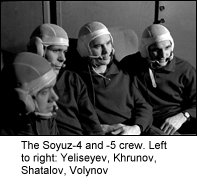 Soyuz-4
and Soyuz-5 finally carried out the original mission foreseen for the
first
Soyuz mission in 1967, i.e. docking between two manned spacecraft and
transfer
of crew members between the craft. In early 1969 this mission was
almost
obsolete and had little connection with the major Soviet manned
spaceflight
project at the time, the N1-L3 manned lunar mission.
Soyuz-4
and Soyuz-5 finally carried out the original mission foreseen for the
first
Soyuz mission in 1967, i.e. docking between two manned spacecraft and
transfer
of crew members between the craft. In early 1969 this mission was
almost
obsolete and had little connection with the major Soviet manned
spaceflight
project at the time, the N1-L3 manned lunar mission.
However, the Soyuz-4/5
mission
was a technical milestone important for the future development of
manned
space stations. The date of this mission was not known ahead of time
and
there were no pre-launch rumors in Moscow during the days leading up to
the launch. But after the flight of Soyuz 3 the "chief designer"
(now known to be V.P Mishin) told reporters that the next mission would
involve the docking of two Soyuz craft and that "we are already
prepared
for a new launch" (2).
The launch of the first
craft
was initially planned for January 13, but a problem in the launch
vehicle
delayed the lift-off by one day (6).
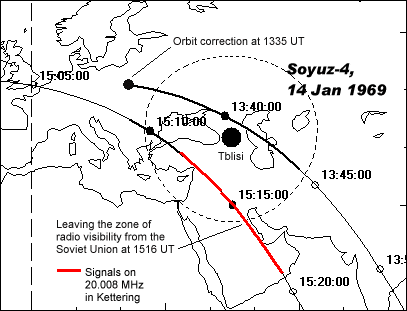 Launch
of Soyuz-4 on 14 January 1969
Launch
of Soyuz-4 on 14 January 1969
Soyuz-4 (spacecraft #12)
was
launched from launch complex 31 at Baikonur on Tuesday, 14 January 1969
at 0730 UT (11) with cosmonaut
Vladimir
Shatalov on board. The call-sign for Soyuz-4 was "Amur". On the
fifth
revolution at 1335 UT the spacecraft, as per standard practice, raised
its orbit from 173-225 km to 207-237 km, both orbits at 51.7 degrees
inclination.
About an hour and a half later, at 1516 UT, the spacecraft left the
zone
of radio visibility from the Soviet Union and at 1700 UT Shatalov
retired
to rest in the orbital compartment. During the last pass over the
Soviet
Union first signals acquired by Kettering station on 20.008 MHz at
1511:48-1519
UT. TASS had announced the transmission frequency 20.008 MHz (3).
Launch
of Soyuz-5 on 15 January 1969
When the mission started
everyone
expected that it would be a rendezvous and docking between two
manned
Soyuz craft. Therefore, the launch of Soyuz-5 (spacecraft #13) the
following
day was fully expected. The launch took place as expected at 0704.57 UT
(11)
on 15 January 1969 from launch complex 1 (the "Gagarin Pad") with Boris
Volynov, Alexei Yeliseyev and Yevgeny Khrunov onboard. The orbit
achieved
was 200-230 Km. The call-sign for Soyuz-5 was "Baikal". The launch was
announced by Western media at about 0830 UT. TASS had announced the
transmission
frequency 15.008 MHz
(4).
At injection into orbit
the
two craft were about 1200 km away from each other and according to
Soviet
sources two-way contact was established between the two craft (1).
The orbit of Soyuz-5 was adjusted at 1430 UT to reach 211-253 km.
Soyuz-5
was the passive ship and Soyuz-4 was the active chaser craft.
Rendezvous and
docking
on 16 January 1969
A first-orbit rendezvous
and
docking as rehearsed during the Kosmos-212/213 flight had originally
been
planned but replaced by a leisurely one-day rendezvous phase (6).
The approach of Soyuz-4 to Soyuz-5 is shown below using the element
sets
on rev 7 for Soyuz-5 and those on rev 14 for Soyuz-4 (see separate
listing). At 0506 UT, about three hours before docking, the orbit
of
Soyuz-4 was adjusted in preparation for the final approach. The Igla
approach control system was switched on at 0737 UT over the South
Pacific.

The figure below shows
the
range-rate between the two craft (negative range-rate means that the
two
craft are approaching). Near closest approach the range-rate fell to
values
well within the capability of Igla to handle.
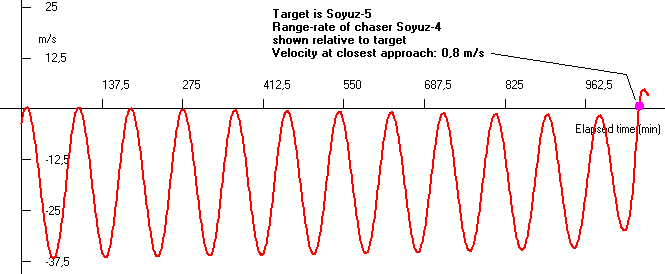
The craft approached to
within
40 meters as they crossed the African coast at 0805 UT. The
docking
occurred at 0820 UT while passing over Soviet territory within view of
Yevpatoria in the Crimea (see map below). When the two docked craft
passed
over South America on the next orbit at about 0925 UT Yevgeny
Khrunov
peformed an EVA to transfer from Soyuz-5 to Soyuz-4. Alexei Yeliseyev
repeated
this maneuver when the docked vehicles passed over the Soviet Union
about
half an hour later. During this period signals on 20.008 MHz were
received
at Kettering (see figure below).
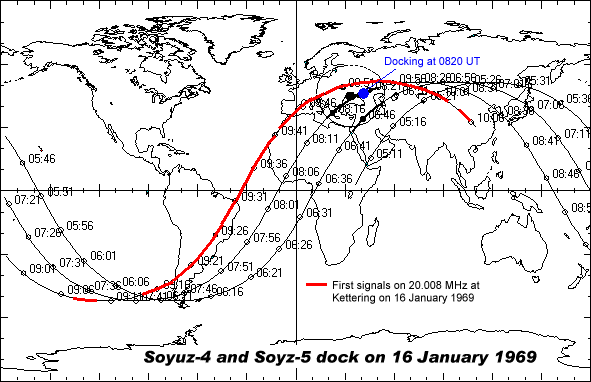
Undocking occurred
again
over the radio horizon of Yevpatoria at 1255 UT.
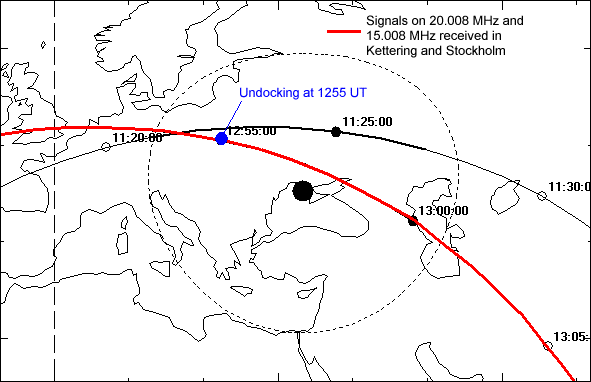
Radio
tracking
of the mission by the Kettering Group
As soon as the mission got
under
way, the Kettering
Group swung into action. The announced frequency for Soyuz-4 was
20.008
MHz
confirming that the traditional Soyuz frequencies would be used.
Therefore
the main emphasis in listening was put on 20.008 MHz and 15.008 MHz
which
was the announced frequency for Soyuz-5. It seems that this is indeed
how
the radio frequencies were used, but when Soyuz-4 had landed Soyuz-5
was
heard on both frequencies. In addition, the CW-PDM
frame length seemed to have been different for the two craft. Soyuz-4
had
a frame length of about 17.3 seconds, while that of Soyuz-5 was 18.3
seconds.
World-wide
coverage
In the graph below I have
summarized
all observations by the Kettering Group. I have not made
distinction
between the two craft, but in general signals on 20.008 Mhz before
the
landing of Soyuz-4 cane from that craft and signals on 15.008 MHz
probably
came from Soyuz-5. Of course, after the landing of Soyuz-4, all signals
came from Soyuz-5. The graph reflects a combination of transmission
patterns
from the two spacecraft, the day/night conditions at the the tracking
sites,
the daily schedules of the trackers and short-wave propagation
conditions.
In any case, the early morning hours UT seem to be rather "empty" of
signaling.
On the other hand, during January 15 and 16 the Kettering Group heard
the
two craft for 9-10 hours each day.
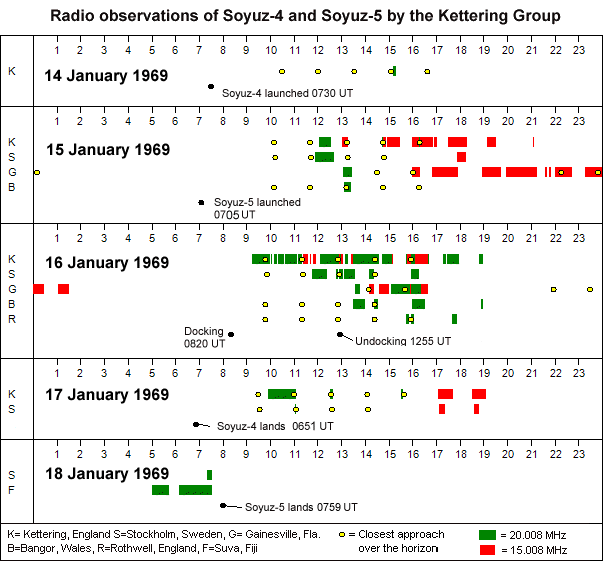
As for myself, I had
just
started to work full time for the Institute of Meteorology at the
University
of Stockholm after having finished my M.Eng degree. Therefore, I had to
rely on my time switch to record signals while at work. This also
limited me to covering just one frequency, because I had to leave the
radio
(an Eddystone EC-10) switched on and tuned to a precise frequency when
I left home. On 14 january I learned of the launch when I picked up the
afternoon papers at 1630 UT and saw a little flash item about the
launch
of Soyuz-4. The next day, when Soyuz-5 was launched I returned home for
an hour around lunch to listen to the recorded tape (which was empty)
and
pick up signals on 20.008 MHz in real time. This became my routine for
the two following days - using the time switch and going home for lunch
to pick up signals in real time.
Biomedical
subcommutation
On January 15, 1969, the
first
day of the flight of Soyuz-5 carrying a three-man crew, word 8 in the
15.008
MHz signal from Soyuz-5 was observed in Kettering to vary in length,
producing
at time three short pulses in the middle of the frame. Upon later
investigation
it was found that it had one of three values, short, medium or long.
The
graph below shows this effect in a recording from Soyuz-4 made on the
16
January 1969 that I have recently located in my old reel-to-reel tape
spools.
Not until the flight of
Soyuz-6,-7-,8
was the significance of this was understood. Soyuz-8, with a two-man
crew
exhibited only two word lengths, medium and long. Then it was fully
understood
that the number of levels that word 8 could assume represented the
number
of crew members on board. At the time of the recording below where word
8 assumes three different lengths, there were indeed three crew members
on board Soyuz-4. It seems that word 8 indicates which cosmonaut is
being
sampled by other telemetry channels. Indeed, word 4 was found to show
variations
consistent with such a scheme (8).
Indeed,
in the figure below it is easy to see variations of word 4 between
frames.
Here is Geoff Perry's
account
of how he discovered the "biomedical subcommutation" in the signal from
Soyuz-8 (9):
"... 15
October
1969: ... Periodic variation of eighth word found to be 2.0 min; the
same
as on previous day, so decided that this was not due to tumbling after
all. John Marshall [another teacher at Kettering Grammar School] had
suggested
whilst we still thought it to be tumbling that the length would provide
an attitude read-out. Devoted the two-period lesson in afternoon with
4P
to evolving theory that this was evidence of sub-commutation - the
alternate
sampling of two cosmonauts at one minute intervals. This suggested that
at a certain time the sequence of three medium length and four
long
pulses should change to four medium followed by three long. This
prediction
was confirmed during the transit from 1402 to 1420 Z and again on the
following
transit. Felt great excitement at this discovery. ...
..16 October
1969....
I mentally determined to go back to the Soyuz 4 and 5 tape recordings
to
see if I could locate evidence for a three-cosmonaut crew. ....
.. 27 October 1969
..
Spent morning (and part of yesterday afternoon) making pen records from
Soyuz 4 and 5 tapes. It is possible to see three cosmonauts in Soyuz 5
as the eighth word shows the following sequence of short, medium an
long
pulses: SSS MMM LLL SSS MMMM LLL SSSS etc. Moreover you can see this
pattern
appear in Soyuz 4 after they have performed the EVA crew transfer ..."
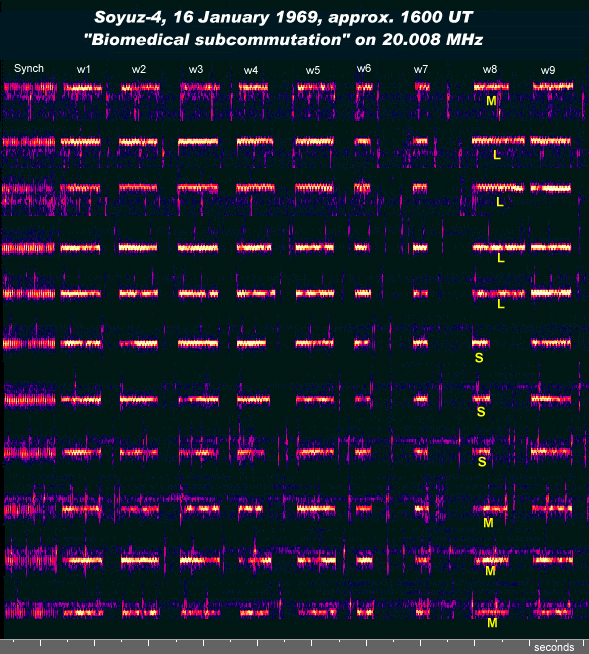
The entire telemetry
sequence
is available here
(warning! the file size is 0.6 MB) for listening. The reader can try
identifying
the subcommutation by simply listening to the recording.
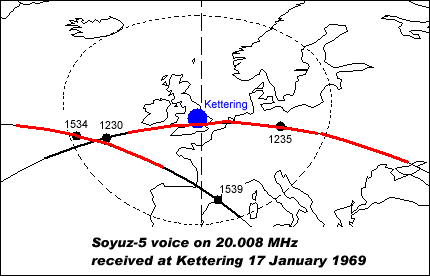 Voice
on shortwaves
Voice
on shortwaves
During the flights of the
Vostoks
and Voskhods short waves was very much used for voice communications,
so
the Kettering group was much disappointed at the lack of voice on
shortwaves
during the flight of Soyuz-4 and Soyuz-5. We now know that the main
voice
link was on 121.75 MHz and short waves was a back-up voice link.
However, a short voice
transmission
was picked up from Soyuz-5 in 17 January 1969 at 1231 UT on 20.008 MHz
when Boris Volynov could be heard calling "Zarya ya Baikal". Additional
voice was picked up at Kettering briefly at 1505.50 UT and also
at
1532-1537 UT. I had my receiver and tape recorder running under time
switch
control at the time, but the BFO (beat-frequency oscillator) was on
preventing
clear reception of the voice. Interestingly, the voice receptions
coincided
with passes over the horizon at Kettering.
Little did we know that
short
waves was used to broadcast messages to the crew giving times for VHF
communications
sessions. This subject is covered in a
separate article.
Telemetry
during the final orbit of Soyuz-5
Myself and Christopher
Wood
at Fiji heard signals on 20.008 MHz from Soyuz-5 the morning it landed.
We both heard the command-off of the 20.008 MHz signal at 0732.41
UT.
I have not been able to locate the tape recording of this event, but I
have kept a servo-pen recording of the last two and a half telemetry
frames
before the command-off. These are reproduced below. "r" denotes the
synchronization
signal. Word 7 was long here even though this was thought to be an
indication
of the docked state as observed during the docked flight of Soyuz-4 and
-5.
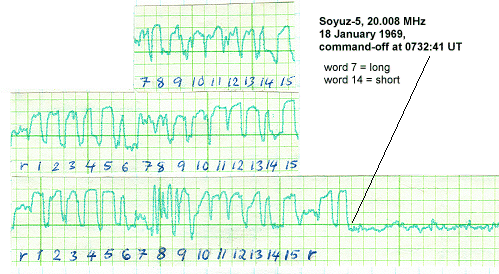
The mission
ends - dramatically for Soyuz-5
The retro-fire for
Soyuz-4
occured at 0611 UT on Friday 17 January 1969. Soyuz-4 landed at 0650.47
UT at a spot about 40 km NW of Karaganda, where the temperature was -35oC
(1).
Sports commissar Ivan Borisenko received the cosmonauts and peasants
from
the "Bersznyaki" collective farm rushed to the scene (5).
The end of the Soyuz-5
flight
was not so routine. The original plan was to land at about 0630 UT and
for Volynov to orient the ship manually for retro-fire. He even
rehearsed
this on the pre-landing orbit and reported that he had completed the
task
in the 9 minutes available. Despite this Volynov was directed to try
the
manual orientation. The spacecraft left eclipse at 0539 UT and the
planned
retro-fire was at 0548.49 UT. At about 0556 UT Volynov reported (to the
ship off Africa?) that he had not had enough time to complete the
maneuver.
However, stored commands to carry out an automatic orientation on the
next
orbit had already been uplinked. The automatic sequence for orientation
and retro-fire worked as planned. (12).
After the end of
retro-fire
the instrument module did not separate despite the fact the
explosive
bolts fired. Boris Volynov could see the antennas on the solar panels
and
realized that the instrument module was till attached. he reported this
through some coded radio channel to mission control (7).
This could have been on short waves soon after the end of retro-fire
because
the spacecraft was still out of VHF range from the Soviet Union at that
time. The report could have been sent later, through VHF, when
approaching
Soviet ground stations, but while still not in the reentry blackout
phase.
It is interesting to note that signals on short waves ceased abruptly
at
0732.41 UT. Myself and Christopher Wood at Fiji heard the command-off.
This is normally assumed to be the time of separation of the instrument
module, and in all probability it was the time when the separation
pyros
fired. Probably the electrical connections but not the mechanical
connection
between the re-entry vehicle and the instrument module were severed.
This was a
life-threatening
situation. Eventually, propellant tanks in the instrument module
exploded
due to the re-entry heat and the two modules separated. The re-entry
vehicle
which had taken the reentry aerodynamic and heat loads in the area of
its
top hatch swung around to the normal re-entry attitude and made a
purely
ballistic reentry. Upon landing the parachute had problems to deploy
properly,
but the craft landed, and the landing shock was such that Volynov was
thrown
across the cabin and broke some of his front teeth. A
detailed account of this near-disaster can be found at James Oberg's
web
site. According Encyclopedia Astronautica a failure of the
soft-landing
rockets caused the landing to be much harder than usual (10).
The map below shows the
final
orbits of Soyuz-5, receptions by myself in Stockholm and Chris Wood at
Fiji in addition to the planned and actual landing spot. Interestingly,
TASS announced the intended landing spot and not the actual one, which
was 600 km short of the planned one (7).
The drama of the landing was not known at the time, it was revealed
much
later, in the 1990's.
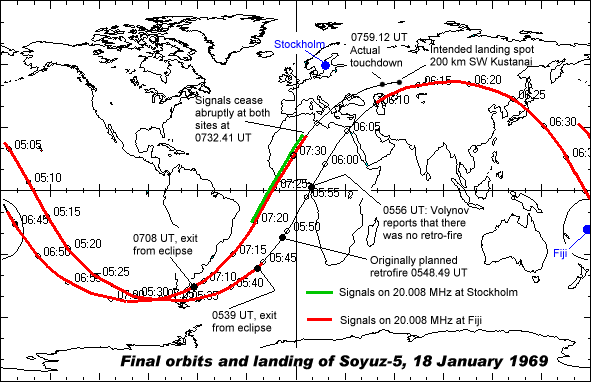
References
and notes
-
"The
joint flight of Soyuz 4 and Soyuz 5, 1969-4A and 1969-5A. Cospar
Station
2289, Kettering." Internal Kettering Group memo written by Geoff Perry
and dated 8 April 1969.
-
Winston,
Donald C, "Soyuz series aims for orbital platform", Aviation Week
&
Space Technology, Nov.18, 1968, pp.121-123.
-
Conquest
of Cosmic Space by the USSR, official TASS communiques and
material
from the central press, 1967-70, Nauka Publishers, Moscow 1971, p. 57.
-
Conquest
of Cosmic Space by the USSR, official TASS communiques and
material
from the central press, 1967-70, Nauka Publishers, Moscow 1971, p. 63.
-
Swedish
daily Dagens Nyheter, 18 January 1969, p.1.
-
Siddiqi,
Asif, "Challenge to Apollo", NASA SP-2000-4408, p.670.
-
Siddiqi,
Asif, "Challenge to Apollo", NASA SP-2000-4408, p.673.
-
Perry,
G.E., Flagg, R.S., "Telemetry from Russian Spacecraft", JBIS, Vol.
23, pp. 451-464, 1970
-
Perry,
G.E, Day-to-day-log for October 1969. Personal communication to Sven
Grahn,
1969
-
www.astronautix.com.
Article
about Soyuz-5.
-
Many
thanks to Ralph Schneider for clearing up the mystery as to the
difference
in launch times for Soyuz-4 and Soyuz-5 given by various sources. The
launch
time quoted by TASS for Soyuz-4, 0739 UT, is actually the time of entry
into orbit. The correct launch time is 0730 UT. This agrees well with
the
time of the zero:th revolution equator crossing time for Soyuz-4, which
is 0719 UT using NORAD element sets. The launch time of a Soyuz is
11-12
minutes after the virtual equator crossing, giving a launch time
of 0730-0731 UT, in good agreement with the figure 0730 given by
Nikolai
Kamanin in his diaries. (See ref 12 below.)
-
Bart
Hendrickx,
The Kamanin Diaries 1969-171, JBIS, Vol 55 No. 9/10, pp.312-360.

 Back
to "Space Tracking Notes"
Back
to "Space Tracking Notes"
 Soyuz-4
and Soyuz-5 finally carried out the original mission foreseen for the
first
Soyuz mission in 1967, i.e. docking between two manned spacecraft and
transfer
of crew members between the craft. In early 1969 this mission was
almost
obsolete and had little connection with the major Soviet manned
spaceflight
project at the time, the N1-L3 manned lunar mission.
Soyuz-4
and Soyuz-5 finally carried out the original mission foreseen for the
first
Soyuz mission in 1967, i.e. docking between two manned spacecraft and
transfer
of crew members between the craft. In early 1969 this mission was
almost
obsolete and had little connection with the major Soviet manned
spaceflight
project at the time, the N1-L3 manned lunar mission.
 Launch
of Soyuz-4 on 14 January 1969
Launch
of Soyuz-4 on 14 January 1969





 Voice
on shortwaves
Voice
on shortwaves
